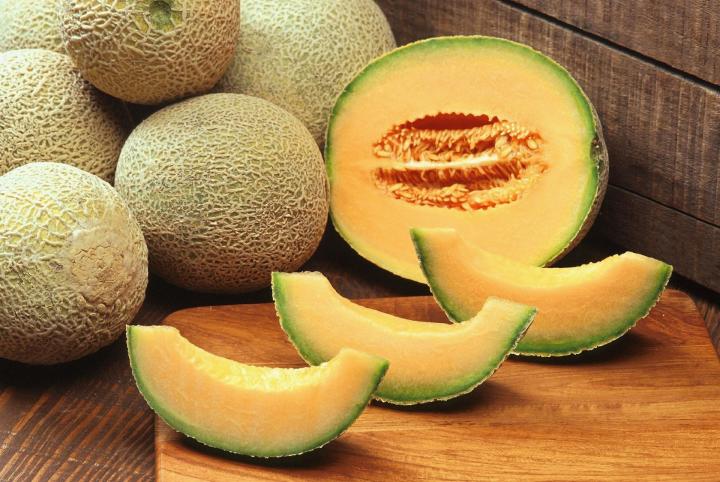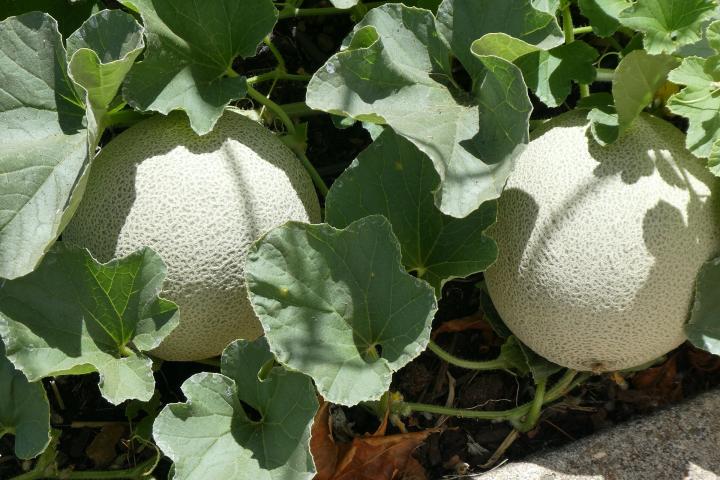How to Grow Cantaloupes: Plant, Care For, and Harvest Sweet Summer Melons
Botanical Name
Cucumis melo
Subhead
Learn how to grow delicious, heat-loving cantaloupes (muskmelon)
Sign up for daily gardening advice and tips
Nothing whispers summer like a chilled slice of sweet, orange cantaloupe juice dribbling down your chin. Good news: these sun-loving melons are easy to grow—and even easier to devour. Let’s get planting!
About Cantaloupes
Cantaloupes are a type of melon with a tan-green rind. Typically, the rind is covered in a spiderweb-like pattern, though some varieties may also be striped. Inside, the flesh is bright orange and sweet. Their growing requirements are similar to those of other popular melons, such as watermelons and honeydew melons.
Cantaloupes vs. Muskmelons
Oddly enough, the melon that is commonly referred to as a “cantaloupe” in North America is not a true cantaloupe, which is more common in Europe. In fact, our “cantaloupes” are a type of muskmelon. (True cantaloupe has a rough, warty rind and is not widely grown or commercially available in the US and Canada.) In North America, the names “muskmelon” and “cantaloupe” are used interchangeably, but we will refer to this fruit simply as “cantaloupe” on this page to avoid confusion!

Planting
Plant in a spot that gets full sun (6 to 8 hours of direct sunlight per day) with well-draining soil that’s a mix between loamy and sandy. (Growing the plants in raised rows—aka “hills”—ensures good drainage.) Amend the soil with aged manure or compost before planting. Learn more about soil amendments and preparing soil for planting.
Mulching the planting site with black plastic will serve multiple purposes: it will warm the soil ahead of planting, hinder weed growth, and keep developing fruits clean.
When to Plant Cantaloupes
This warm-season, very tender crop thrives in heat and hates the cold! It thrives in warmer climates with longer growing seasons.
- It’s best started directly from seed. If you live in a warmer climate, you may direct sow seeds outdoors after all danger of frost is well past and when the soil temperature warms to at least 70°F (21°C).
- However, if you’re set on growing cantaloupes in a colder region, you can start seeds indoors 4 to 6 weeks before your last spring frost date. Transplant outdoors 2 to 3 weeks after the last spring frost when the soil is at least 70°F (21°C).
How to Plant Cantaloupes
- Plant seeds 1 inch deep, 18 inches apart, in hills (or hilled rows) about 3 feet apart.
- If you have limited space, vines can be trained up a support, such as a trellis.
- If you plant indoors, use peat pots or soil blocks to avoid root disturbance. Harden off seedlings before transplanting.

Growing
- If a soil test indicates that nutrients are lacking, fertilize with a standard liquid fertilizer when vines start growing and spreading. Later on, avoid nitrogen-heavy fertilizers, as too much nitrogen can result in lots of foliage and less fruit.
- Row covers are a good way to keep pests like squash bugs and vine borers at bay.
- Watering is key. While the plants are growing, blooming, and setting fruit, they need about 2 inches per square foot of water (about 1.5 gallons) per week.
- Water in the morning, and try to avoid wetting the leaves, as wet foliage encourages fungal and other diseases.
- If possible, use drip irrigation to keep plants consistently and evenly watered.
- Mulching around the plants can help to retain moisture.
- Reduce watering once fruits are growing. Hot, dry weather produces the sweetest melons.
- If you’ve had an exceptional amount of rainfall during the ripening stage, this can cause bland fruit.
- Once fruit begins to grow, prune end buds off vines. Your plants may produce fewer melons, but they will be larger and of better quality.
- Vines produce male and female flowers separately on the same plant. They often begin producing male flowers several weeks before the females appear. (Don’t be discouraged when the first blooms do not produce fruit.)
- As with other cucurbits, melon flowers require pollination to set fruit, so be kind to the bees!
- If your muskmelons taste bland, the trouble could be a lack of magnesium in sandy soil. Sweeten the fruit by spraying the vines with this solution: Dissolve 6 1/2 tablespoons of Epsom salts and 3 1/3 tablespoons of borax in 5 gallons of water. Spray the foliage when the vines begin to “run” and again when the fruit is about two inches in diameter.
Types
- ‘Ambrosia‘ – 85 days to maturity. Among the sweetest varieties.
- ‘Athena‘ – 70–80 days to maturity. Early variety that produces large, 5- to 6-pound fruits.
- ‘Hale’s Best Jumbo’ – 80–90 days to maturity. Produces 3-pound aromatic melons.
- ‘Minnesota Midget’ – 70–80 days to maturity. Early variety well-suited for gardens in colder regions. Produces 1-pound, sweetly flavored melons.
- ‘Bush Star’ – 90 days to maturity. Bush variety suits gardeners with limited space.
Harvesting
How and When to Harvest Cantaloupes
- When rinds begin to change from green to tan or yellow, the melon is typically ripe enough to pick. Be careful not to pick too early, however.
- Look for a crack in the stem where it attaches to the fruit. This is a sign of ripeness as well. The fruit should be easy to separate from the vine, but if they fall off by themselves, they are usually overripe.
- Harvest melon when vines are dry, and be careful not to damage them.
- Melons will soften after harvesting but will not continue to sweeten off the vine.
- Cantaloupe can be stored uncut for 5 or 6 days. If cut, they can last in the refrigerator for about 3 days, wrapped tightly in plastic.
Pests/Diseases
Cantaloupe Pests and Diseases| Pest/Disease | Type | Symptoms | Control/Prevention |
|---|
| Aphids | Insect | Misshapen/yellow leaves; distorted flowers; leaf drop; sticky “honeydew” (excretion) on leaves; sooty, black mold | Knock off with water spray; apply insecticidal soap; inspect new plants carefully; use slow-release fertilizers; avoid excess nitrogen; encourage aphid pests such as lacewings, ladybugs, spiders |
|---|
| Cucumber beetles | Insect | Holes in leaves/flowers; rasped fruit; plants stunted/die; may transmit bacterial wilt (Bacterial wilt signs: wilting; plants die; ends of cut stems, when pressed together for 10 seconds and pulled apart, release stringy, white sap) | Handpick; mulch heavily; use row covers; destroy plants infected with bacterial wilt |
|---|
| Cucumber mosaic virus | Virus | Stunting; mottled green/yellow/white pattern or ringed spots on leaves/fruit; distorted leaf growth; warts on fruit | Destroy infected plants; choose resistant varieties and certified virus-free seed; use row covers; disinfect tools; weed; control aphids; use mulch |
|---|
| Fusarium wilt | Fungus | Plants wilt (sometimes on just one side) in daytime; leaves turn yellow (lower ones first); later, entire plant wilts/dies; stunting; stem cross section reveals brown discoloration | Destroy infected plants; avoid excessive nitrogen; in acidic soils, raise pH to 7.0; choose resistant varieties; disinfect tools; rotate crops |
|---|
| Powdery mildew | Fungus | Typically, white spots on upper leaf surfaces expand to flour-like coating over entire leaves; foliage may yellow/die; distortion/stunting of leaves/flowers | Destroy infected leaves or plants; choose resistant varieties; plant in full sun, if possible; ensure good air circulation; spray plants with 1 teaspoon baking soda dissolved in 1 quart water; destroy crop residue |
|---|
| Squash vine borers (moth & larvae) | Insect | Large, wrinkled larvae become orange-red/black, wasp-like, daytime moths; larvae bore into vines; vines wilt suddenly; plants die; mushy area and/or green to orange-yellow, sawdust-like excrement on/near base of plant stem | If detected early, slit infested stem lengthwise halfway to remove borer(s), then bury the cut in moist soil to encourage rooting; wrap seedling stems in aluminum foil collar; catch moths with yellow sticky traps; use row covers if no pests previously, but uncover before flowering; destroy crop residue; rotate crops |
|---|
Wit and Wisdom
- Cantaloupe was named for Cantalupo, a former papal villa near Rome.
About The Author
Catherine Boeckmann
Catherine Boeckmann loves nature, stargazing, and gardening so it’s not surprising that she and The Old Farmer’s Almanac found each other. She leads digital content for the Almanac website, and is also a certified master gardener in the state of Indiana.
Read More from Catherine Boeckmann





